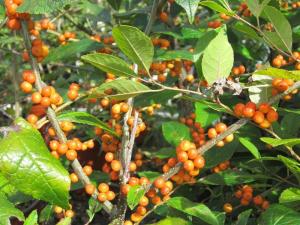What is not to love about winterberry hollies? For one thing, they are native to pretty much all of the eastern United States. They have great fall color and can tolerate wet soils. They are available in a range of different heights. All those benefits plus showy berries in the fall!
Winterberry hollies (Ilex verticillata) are deciduous shrubs. While they are in the holly family, they do not have prickly leaves. The leaves emerge in the spring and stay green all summer until they turn showy yellow in the fall. The growth habit is upright, and height range can range from 4 feet to 15 feet depending on cultivar. They can grow in full sun to shade, but they do prefer moist soils. Flowers are small, white and not very showy in late spring.
The best feature of winterberries happens in the fall and into the winter. Brilliant berries form in shades of red and gold along the stems. The berries attract and feed birds in the winter. Do not eat the berries, however, since they are poisonous to humans. Cut the branches to add some color to winter planters with evergreen foliage. Winterberries do require a male plant for pollination. Make sure the male you get flowers at the same time as the female. Only one male plant is needed for however many female plants you have.
Many cultivars of winterberry hollies are available. Sparkleberry is a heavy berry-producing plant with bright red berries that gets to about 8 to 10 feet. Another red-berried cultivar is Winter Red, a medium-sized plant that produces large berries. If you don’t have much space in your yard, try Red Sprite. It has red berries and only grows to 3 to 4 feet.
A newer cultivar that also stays small and berries heavily is Berry Poppins. Afterglow gets 4 to 6 feet tall and has orange-red fruits. Not all winterberries have red berries. Winter Gold has gold berries and grows 6 to 9 feet. Sunsplash is a variegated form of winterberry with green leaves splashed with yellow. It is a showstopper in the yard, but it does not produce many berries. Male cultivars that are available are Southern Gentleman, Jim Dandy, and Mr Poppins.
Winterberry hollies are extremely easy to grow as long as they have moist soil. The showy berries in the winter feed wildlife, add winter interest in the yard, and make great cut stems to add to winter arrangements. What more could you ask for?

















































